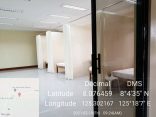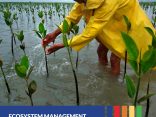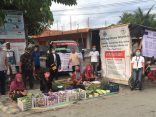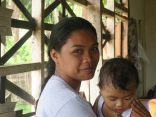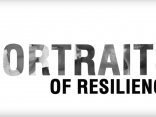Barangay Chairperson Elizalde Miones, “Kap Zaldy” to many, takes his turn in tending the sari-sari store. He records in a logbook every sale of rice, sugar, cooking oil and other prime commodities. He belongs to one of the 11 teams who man the cooperative store in the Mamanwa Village, Barangay Catmon. This is the only store in the village that even some residents of neighboring villages, Sta. Cruz and Magatas, buy their everyday goods from it. The village is home to some 30 families of Mamanwa, a group of indigenous people. This village is also the new home of Kap Zaldy and most of the families from Barangay Malinao.
Not long ago, Kap Zaldy and the residents of Barangay Malinao had to travel three to four kilometers to be able to buy food, supplies, and other needs. Their old village is located at the upland area of St. Bernard where it is inaccessible to any form of transportation even carabaos. One has to painstakingly take the only way down the steep mountain slope and across a river— by foot.
Due to its location, the Malinao village becomes isolated every time heavy rains swamp the river that needs to be crossed to reach or leave the place. At times during disasters, the raging river becomes impassable for days causing the village to starve from the lack of food supply. Their vulnerability due to the threat of landslides is magnified because of poverty and exacerbates the already scarce source of livelihood and food supply.
Led by Kap Zaldy in January 2011, residents of Malinao evacuated to Mamanwa Village in Barangay Catmon. They decided to flee from their barangay because of the growing crack at the slope directly facing the settlement that increased the likelihood of landslides in the area. The situation makes it impossible for them to go back and live in Malinao.
At the onset, many were pessimistic towards permanent evacuation as they experienced being cramped-up like sardines in relocation areas. They were also concerned that they have to leave the only livelihood available to them which are vegetable production, rice and coconut farming. Convinced that the community will be able to make it through, Kap Zaldy encouraged them every day to endure the situation and collectively establish a way of life with their new home.
The Food Facility Project (FFP) was introduced to the community in January 2011 to help them cope-up after the evacuation. The ultimate challenge is to ensure the availability of food despite the occurrence of disasters by providing livelihood activities which are not vulnerable to disasters. An important component is livelihood activities must not contribute to further vulnerability. The beneficiaries of FFP decided to establish a cooperative store.
The main source of livelihood of Kap Zaldy and the community is still rice farming and vegetable production at the old site in Barangay Malinao. FFP provided a total of nine (9) carabaos to help the farmers increase their output. Before the intervention projects, the residents of Malinao employed manual labor in farming and small-scale production which makes it difficult for them to provide for their own families much less for sale as means of profit. Today, they are able to produce a little more for deposit in the cooperative.
The sari-sari store supplements the main source of livelihood for the evacuees. It is also envisioned to serve as a stable source of food and other needs despite the occurrence of heavy rains and other disasters. Today, there is no need to trek the dangerous path just to be able to buy their supplies.
The cooperative store proved to have helped the community adjust in their new home. Cooperative members were entitled to loans which can be paid without interest during harvesting season. From the initial capital of thirty (30) sacks of rice, the cooperative led by Kap Zaldy and other beneficiaries were able to extend the variety of goods available in the store including canned goods, sugar, soap, and other prime commodities.
The beneficiaries were able to maintain this store by fixing a schedule among the 22 beneficiaries to alternately man the store from 6am to 4pm. Kap Zaldy’s wife, Nanay Flordeliza, takes her turn to man the store after 4pm.
To maximize ways to ensure food stability, all the residents were also given support to start “backyard vegetable production” in the relocation area.
Today, the residents who were once highly vulnerable to the threats of disasters in Barangay Malinao are more safely settled in Mamanwa Village, Barangay Catmon. Aside from this, they have reduced their vulnerabilities by setting-up a supplementary source of food and other needs that is less prone to disasters.
The lives of Kap Zaldy and his co-villagers are still struggling with poverty and the need to be prepared for disasters. But the days of uncertainty for food supply during and immediately after disasters were over. The long trek and dangerous rivers were already done away with.
Now, the only road they need to trek is towards further reducing disaster risks and improving the lives of the community.

